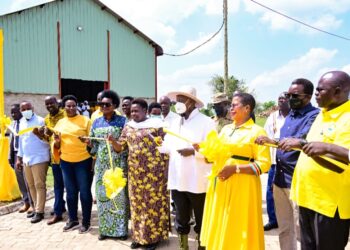According to an announcement by the National Information Technology Authority-Uganda (NITA-U), the ground has officially been broken on a project to prove fibre’s worth to Uganda’s rural communities. Called the Electricity and Fiber to The Village project (EFTTV), the goal of this experiment is to demonstrate the value of greater fibre adoption, and how it might be implemented. As part of a greater push by the Ugandan government to modernize nationwide infrastructure, expectations are high.
The EFTTV Project
As of January 2021, the total internal penetration in Uganda stood at 26.2% or 12.16 million people. This places Uganda’s connectivity somewhere around the middle of the penetration rates over Africa. If this project is successful, however, opportunities for far greater rates of connectivity should result.
The move so far is multifaceted, measuring both implementational viability and practical outcomes. Put in place by the Uganda Communication Commission (UCC), the EFTTV project is targeted at a range of 40 different communities. Each of these communities will be given electrical and internet infrastructural upgrades, and computers that can take advantage of the new potential.
From this point, the UCC aims to measure productivity increases following installation, which will be measured against the prior levels of economic output. Should greater productivity be the result, the government will likely adapt its existing plans to add greater emphasis on rural communities. With more than 4000 kilometres of fibre laid in 49 districts so far, greater development of nationwide internet will continue regardless, but this project could help spread integration into areas more commonly ignored.
Challenges of EFTTV Testing
The idea of testing the effectiveness of greater fibre integration makes sense, but there are possible confounding elements that could skew numbers. The foremost of these is that the introduction of newer technologies is only the first step. Just as important is teaching the local communities how the technologies can be utilised. Without this information, all the improvements in the world could go to waste, which makes drawing accurate implementation troubling.
Ultimately, the solution to this challenge could be found in a two-pronged hardware and teaching approach. By setting up special programs to ensure those with new access to the technology understand how it can be utilised, the true potential of these changes could be measured. Otherwise, these kinds of tests will only scratch the surface and leave a great deal of unexplored territory on the table.
The Outcome of Implementation
Should this testing period prove successful, the implications for rural Ugandan internet users could be immense. Direct local Businesses would be the most obvious recipient of change, but would only act as a start to the potential that a great level of fibre connectivity would produce.
As a side-effect of greater fibre reach, mobile coverage could also see significant benefits. Through connections to cabled fibre, 4G and even 5G towers could reach far deeper into remote areas, with all the communication and safety advantages that better signal reach implies. Such developments could lead to the end of the 2G and 3G era within Uganda, bringing the entire country into the fastest modern tiers of access.
Educational opportunities could also see profound gains when greater connectivity arrives. In the 2020s, online learning is bigger than ever, giving anyone with an internet connection the ability to receive some of the best education in the world. In Uganda, this could help raise standards, which has been long established to generate a positive feedback effect into communities.
Also worthy of note are the changes that better internet could have to entertainment. For an example of this, most new online casinos are now available in rural areas of Uganda already but can suffer performance limitations due to slower connections. Faster internet would streamline every part of these casinos, from the browsing of different opportunities to comparing bonuses, using the sites, and playing the games themselves. This same speed would offer benefits for practically any online entertainment experience, from video streaming to traditional online video games. Many operators now offer customer support for those looking to play their favourite casino games.

While it’s too early to tell of the effect of the EFTTV study yet, indications are strong that it could lead to some very positive and wide-ranging changes. The only questions remaining are how well the testing is being implemented, and whether the result will be enough to justify what will be an undoubtedly expensive and long-lasting investment.
Do you have a story in your community or an opinion to share with us: Email us at editorial@watchdoguganda.com













